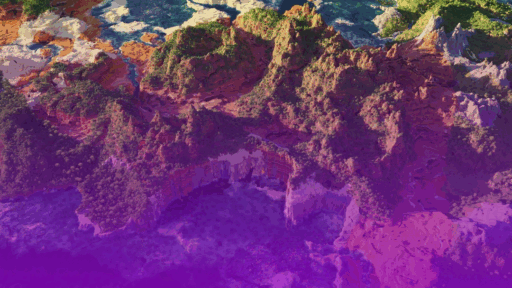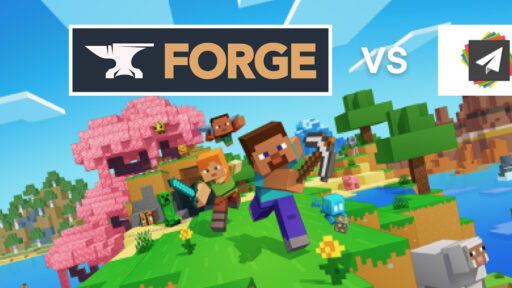Every Minecraft world feels unique, from the moment the loading bar fills in, and you are placed in a landscape full of mountains, forests, and oceans. This experience has led many to ask the question: how does a game create a seemingly infinite and detailed map? It’s not quite magic, but a pretty complex process known as procedural generation.
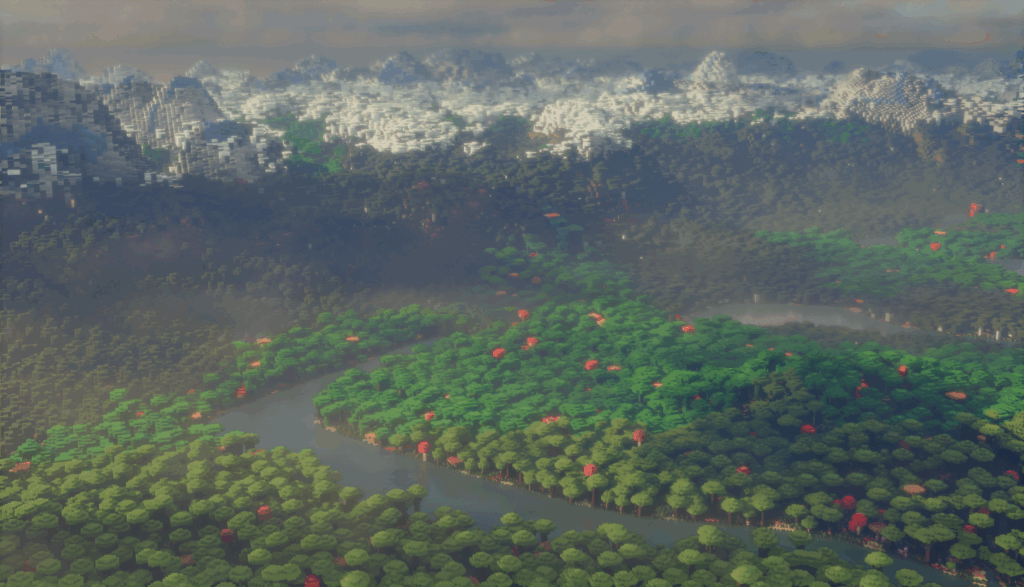
Unlike games with hand made maps, Minecraft does not store its massive environments as equally massive files. Instead, it holds a compact set of instructions and generates the terrain on the fly, block by block, as you explore. The following explains how Minecraft’s generator transforms a string of characters (world seed) into a playable universe.
Universe in a String
At the heart of every Minecraft world is its seed. It is a string of characters that serves as the origin for the entire generation process.
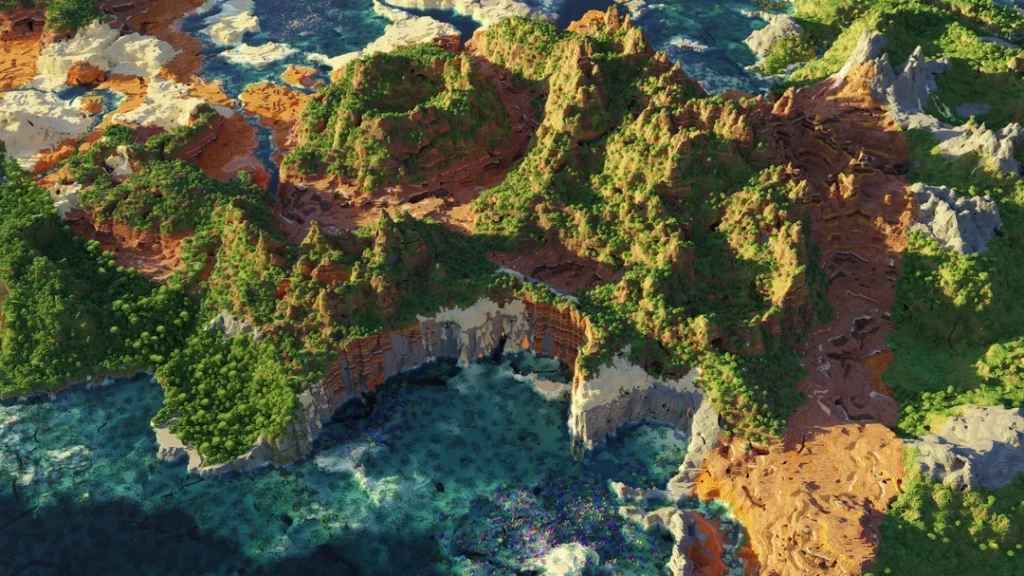
Seed: 1365390787
The Pseudo-Random Number Generator
The seed is not a blueprint or a compressed map. Instead, it is the starting value for an algorithm known as a pseudorandom number generator (PRNG). A PRNG is designed to produce a sequence of numbers which appears random at first, but is actually completely predictable. Given the same initial value and the same game version, the algorithm will produce the exact same series of “random” numbers every time. This principle of deterministic randomness is the basis of Minecraft’s world generation, ensuring landscapes are both unique and replicable.
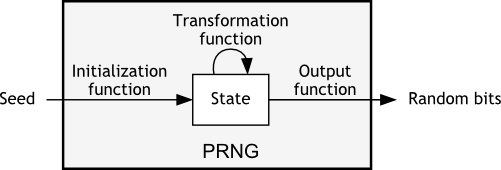
A World on Demand
The game’s code queries this PRNG thousands of times to make decisions: how high should this mountain be? Should a tree grow here? Is there a cave below this spot? Because the sequence is fixed by the seed, the answers are also determined for any given coordinate. This reveals a critical truth: the environment is not stored; it is calculated. A mountain range does not exist until a player gets close enough for the game to run the algorithm for those coordinates, making a “virtually infinite” world possible without endless storage. The engine only needs to retain the seed and the changes you make.
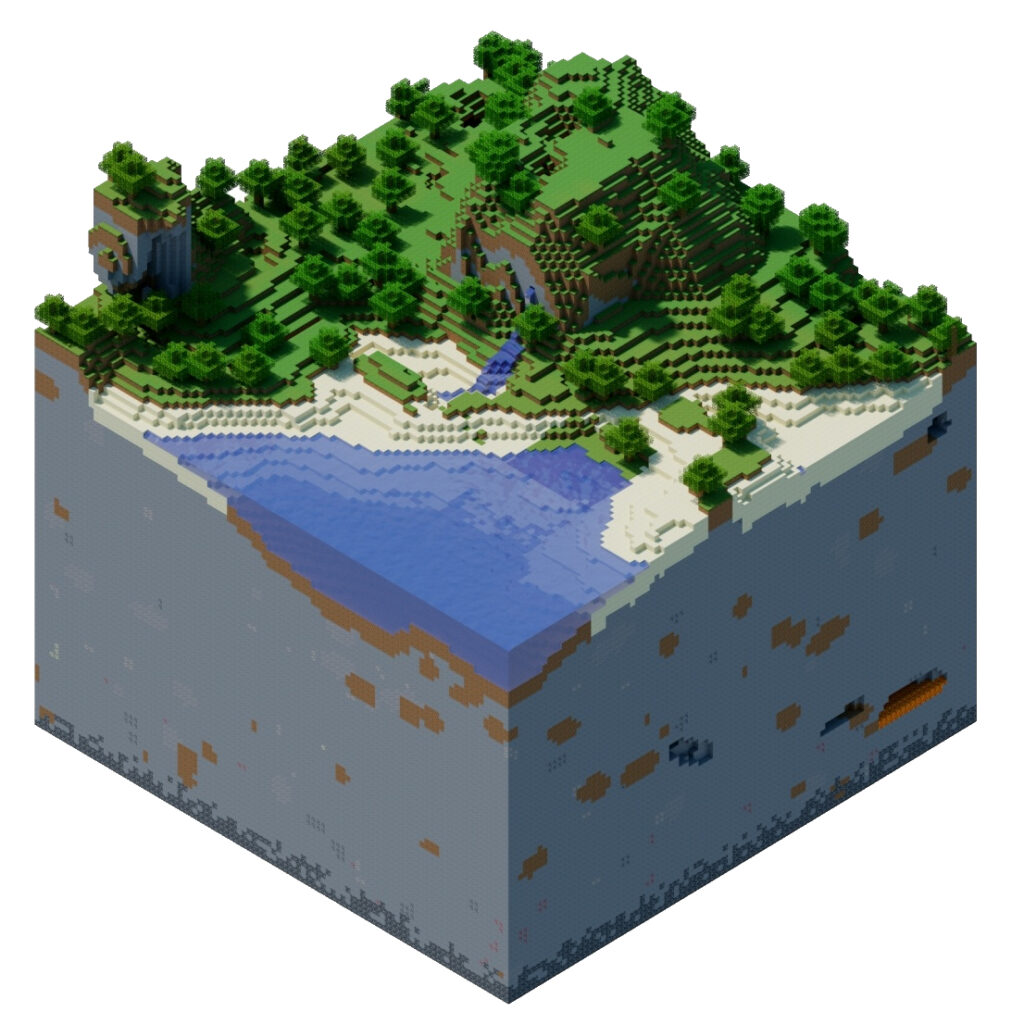
Source: minecraftathome.com
The Scale of Possibility
If you leave the seed field blank, the game generates one using the computer’s system clock. If you enter text, the application converts it into a numerical value. The entire input is treated as a single number; changing even one character creates a completely different world. With 64-bit signed integers, there are over 18 quintillion possible seeds. It would take over 584 billion years to generate them all, one per second.
The Power of Noise
Once the seed has initialized the random number generator, the game needs a way to translate that randomness into natural-looking terrain. Simply assigning a random height to each block column would create a chaotic, spiky mess. To form smooth, organic landscapes, Minecraft employs a powerful mathematical tool known as gradient noise.
The foundational algorithm is Perlin Noise, developed for the movie Tron, and its more efficient successor, Simplex Noise. Their key innovation is producing “coherent” noise. Unlike the static of an old TV, where each pixel is random, the value of any point in a Perlin noise map is related to its neighbors. This creates the smooth, continuous gradients perfect for mimicking natural topography.
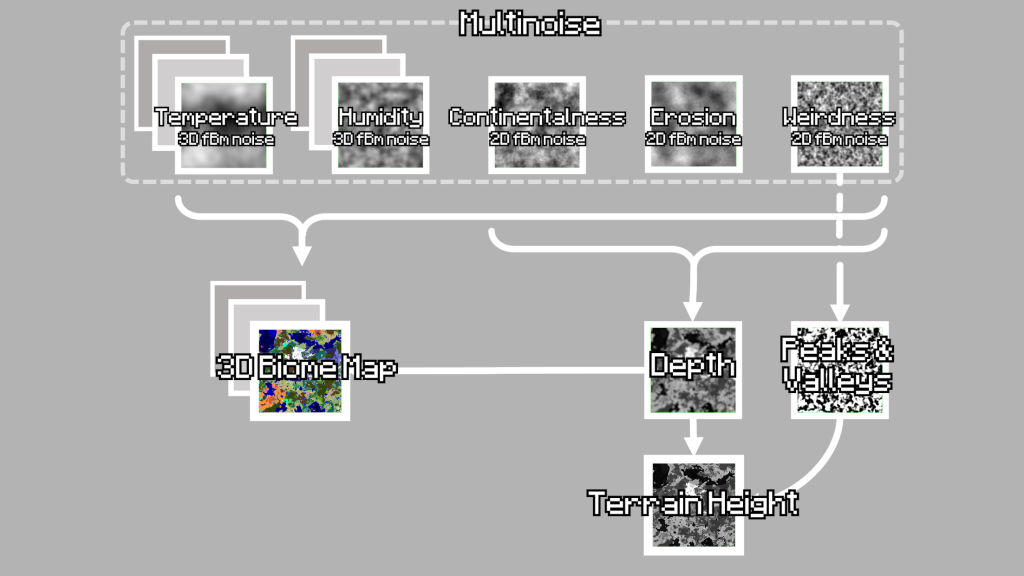
To create more complex and realistic landscapes, Minecraft uses fractal noise, layering multiple noise maps called octaves on top of each other.
- Low-Frequency / High-Amplitude Layer: This first layer uses a large-scale noise pattern to create the broad, foundational shapes of the world; continents, large mountain ranges, and ocean floors.
- High-Frequency / Low-Amplitude Layers: Subsequent layers use smaller-scale noise patterns with less influence. These add finer details, like hills on top of mountains or small variations on plains.
The final height for any point is the sum of these layers. This mimics how real-world geology exists at multiple scales simultaneously, which is why Minecraft terrain feels so natural despite being made of cubes. The same principle is extended into 3D noise to carve out caves and overhangs and can even be used in 4D to produce dynamic effects like shifting cloud patterns.
Building the World in Layers
With the seed providing the randomness and noise functions providing the architectural tools, the game begins the step-by-step process of constructing the world. This pipeline can be broadly divided into two main phases: Generation, which creates the base terrain and defines the biomes, and Population, which adds features like trees, ores, and structures.
The very first step is the creation of a 2D heightmap. Using the layered noise functions, the generator calculates a base elevation for every (X, Z) column. At this stage, the world is only stone, water, and air. Any area with a height value below sea level is filled with water.
Painting the Canvas
Once the shape of the land is determined, the next crucial step is to decide what kind of environment, or biome, each region should be. This process dictates everything from the surface block (grass, sand, or snow) to the types of plants and animals that can appear. Minecraft has used two fundamentally different systems for this task.
The Old Layer-Based System (Pre-1.18)
For many years, biome placement was handled by a multi-stage process. It started with a low-resolution map and applied a series of “layers,” each refining the map and adding detail. This involved defining continents and oceans, assigning broad climate values (Freezing, Cold, Temperate, Warm), smoothing the transitions between them, and finally assigning specific biomes based on those climate zones. Rivers were often carved along the boundaries of different climates.
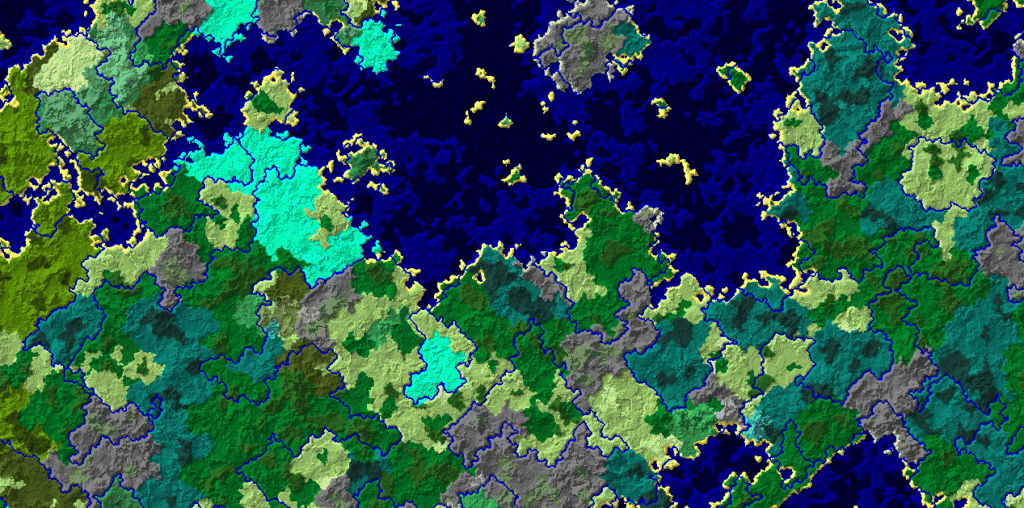
The Current Multi-Noise System (1.18+)
The Caves & Cliffs update introduced a revolutionary new system. Instead of a 2D layer-based approach, the modern generator uses multiple 3D noise maps to define a set of “climate” parameters for every point in the world: Temperature, Humidity, Continentalness (distance from a coastline), Erosion (how flat or mountainous), and Weirdness (for unusual variants).
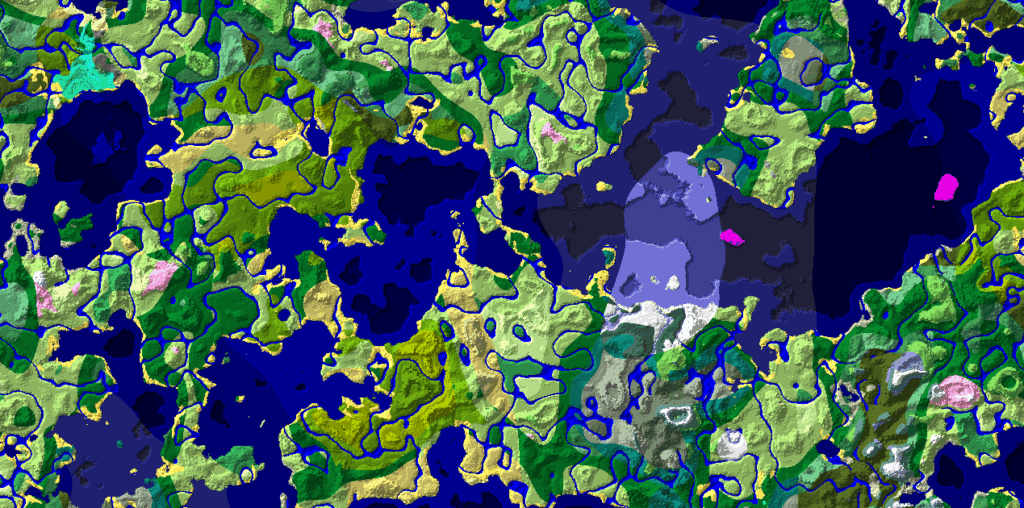
Each biome is defined by an ideal range for these five parameters. To determine the biome for any location, the game calculates the five noise values and assigns the biome whose target parameters are the closest match. This decouples terrain shape from the biome’s surface features, allowing for a vastly more diverse world where a jungle can stretch over a jagged mountain peak, or a desert can nestle in a deep crater. Combinations that were impossible under the old system.
Cave Generation
Just as the surface generation has evolved, so too has the creation of Minecraft’s underground.
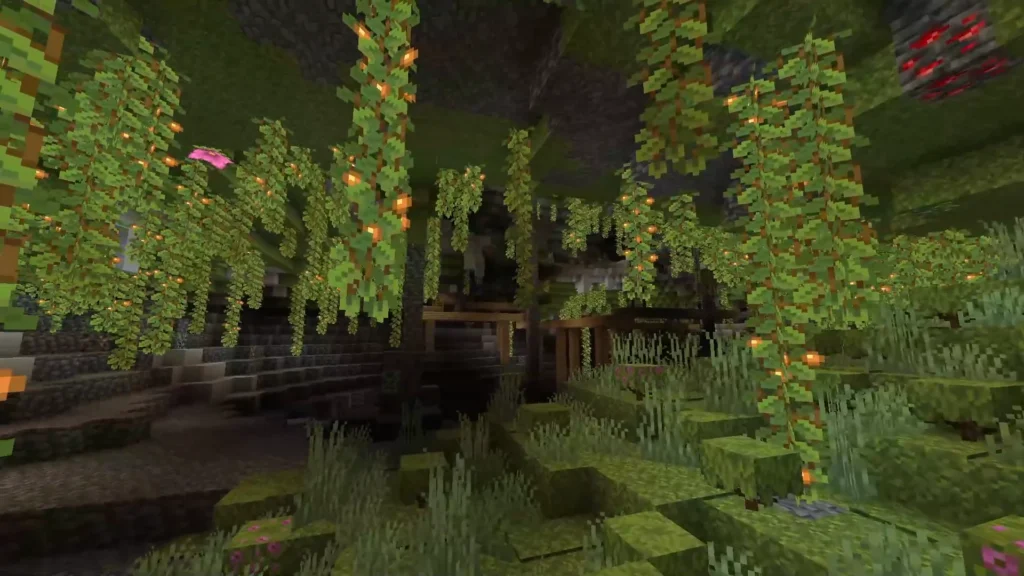
Carvers and “Perlin Worms” (Pre-1.18)
Originally, caves were created through a subtractive process. After the solid stone of the heightmap was generated, algorithms called carvers would tunnel through it. The most common type, often nicknamed “Perlin Worms,” would snake through the world in semi-random paths guided by noise functions, removing blocks to create branching tunnels and ravines.
Noise Caves (1.18+)
The Caves & Cliffs update completely overhauled cave generation with a new additive system based on 3D noise maps. Instead of carving out existing stone, the generator uses 3D noise to decide where stone should be placed in the first place. If the noise value at a coordinate is above a certain threshold, a stone block is placed; if it is below, the block is left as air, creating a cave. This allows for vast, open caverns and produces three main types:
- Cheese Caves: Massive, open caverns with towering stone pillars.
- Spaghetti Caves: Long, narrow, winding tunnels that crisscross the underground.
- Noodle Caves: An even thinner and more claustrophobic variant of Spaghetti Caves.
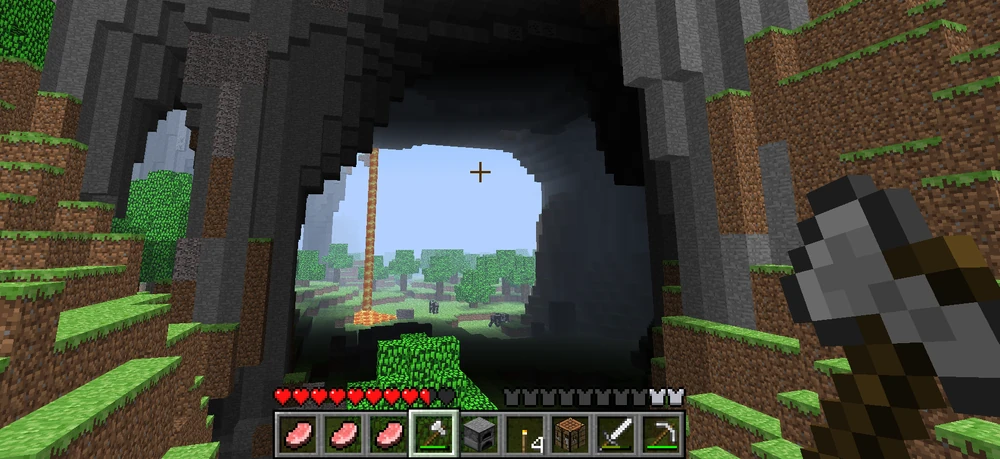
Source: minecraft.fandom.com
Alongside these, the update introduced aquifers: localized bodies of water or lava that generate with their own level, independent of the global sea level, creating stunning underground lakes.
Populating the Landscape
With the fundamental shape of the world established, the final phase begins: population. This is where the world is filled with the details that make it an interactive space.
Ore Distribution
The changes to world height in version 1.18 necessitated a new approach to ore distribution. Most ores now follow a triangular distribution. Instead of being equally common at all valid depths, they are rarest at the top and bottom of their generation range and most abundant at a specific “peak” Y-level. This introduces strategic trade-offs, as the optimal level for diamonds is now one of the worst for finding coal. To balance the new, enormous caves, the generator is less likely to place valuable ores like diamonds where they would be exposed to air, encouraging both caving and methodical strip mining.
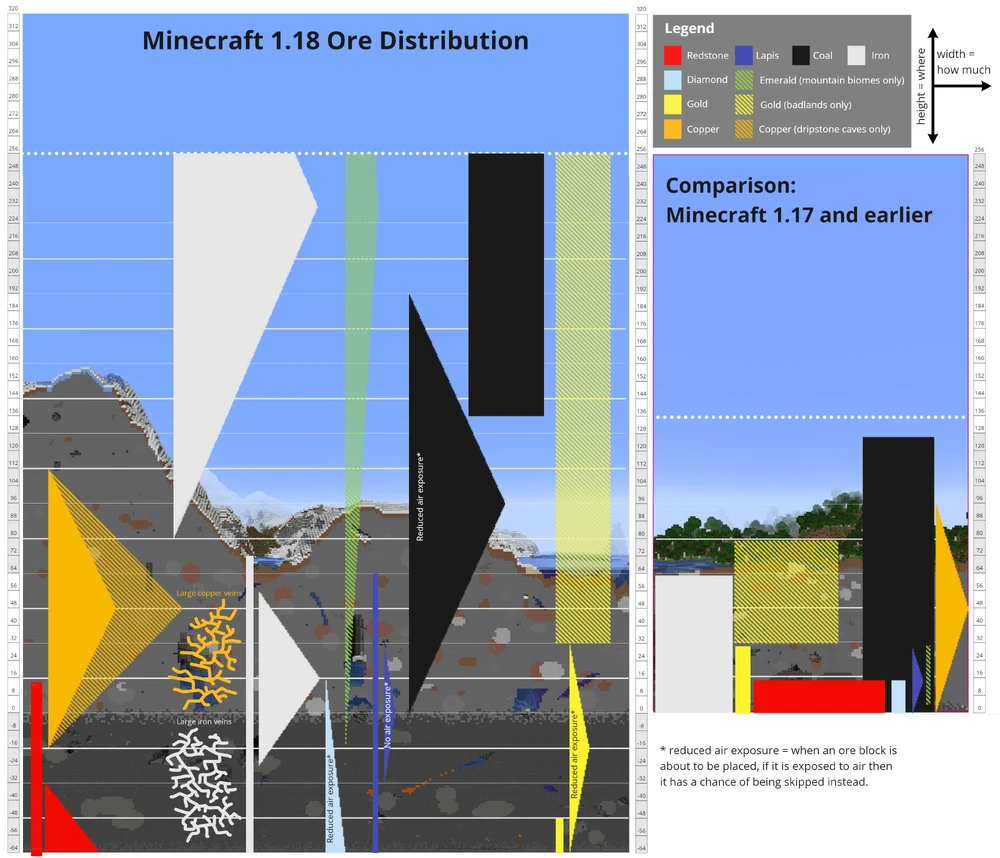
Generating Structures
The final touch is the placement of structures. Their generation is governed by a strict set of rules, using an underlying grid to determine potential locations with parameters for spacing and separation. The most important condition is the biome; a desert pyramid will only attempt to generate in a desert.

For complex structures like villages, Minecraft uses a modular system centered around the Jigsaw Block. This system works a bit like procedural LEGOs: a starting piece is placed, and its Jigsaw Blocks define connection points and a “target pool” of other pieces that can attach. The structure grows piece by piece in this recursive fashion until it reaches a size limit, allowing it to appear organic and adapt to the underlying terrain.
Conclusion
The generation of a Minecraft world is essentially an algorithms that takes a set of numbers and turns it into an entire universe. Using the deterministic randomness of the world seed, the system builds a foundation using the organic gradients of noise functions. It then layers on top by painting biomes, carving caves, and populating the world with resources and structures of a simulated history.
